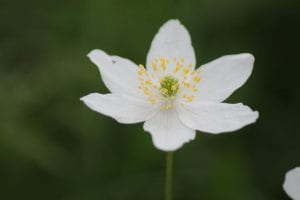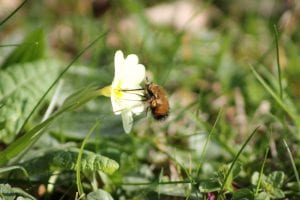By Andy Winfield
 The Garden is open again and we’re all looking forward to seeing visitors back, and they’ll be back in time to catch the optimism of spring throughout the displays. Tulips in the Mediterranean, magnolias in the family beds and ruffled new leaves clambering out of buds and stretching into action. They’ll also see carpets of flowers that we didn’t plant, they were here before the Botanic Garden and maybe before whatever was before the Botanic Garden; they’re Anemone nemerosa otherwise known as wood anemones.
The Garden is open again and we’re all looking forward to seeing visitors back, and they’ll be back in time to catch the optimism of spring throughout the displays. Tulips in the Mediterranean, magnolias in the family beds and ruffled new leaves clambering out of buds and stretching into action. They’ll also see carpets of flowers that we didn’t plant, they were here before the Botanic Garden and maybe before whatever was before the Botanic Garden; they’re Anemone nemerosa otherwise known as wood anemones.
In the Botanic Garden wood anemones are spread prolifically underneath oak trees that are just stirring for another year of their long lives. These flowers have appeared under the bare branches of these trees for many years and are said to be a good indicator of ancient woodland, but what is ancient woodland? In terms of the formation of countryside, our current landscape is actually very recent, geologically speaking. 15,000 years ago most of the country was glacial and we were joined to Europe by huge ice sheets. As the global temperature warmed the earth and the big ice melt began, a huge plain, known as Doggerland, was left between western Europe and East Anglia, over which people travelled into the country bringing plants and animals. As the ice retreated northwards, humans and plant life gradually colonised the landscape from the east and forests began to establish. It is these forests that we call ancient, established around 12,000 years ago on ice free land.

So why is Anemone nemerosa said to be an indicator of these woodlands? While the presence of this plant won’t guarantee that the area where you’re standing is ancient, it will tell you it’s been there a while. Wood anemone takes a very long time to establish to the point of blanketing the understory; a 6 ft patch is said to take 100 years of painstakingly slow establishment. It really is a mission creep with these plants as they tend to spread by root growth rather than seed. For a such a well-established plant it is mighty inefficient; as well as the slow rhizome colonisation it has a hit and miss seed operation as well. The flowers open and close with the light, the sepals protecting pollen from the rain; hoverflies and bee-flies are said to be pollinators and a fatty addition to the seed attracts ants to disperse them; in addition to this complex web of stakeholders, germination requires precise conditions including a cold snap. Once germinated, flowering can take up to 12 years! So, even though spreading through roots is slow, it’s quicker than the alternative.
When looking into this plant it seemed to throw up more questions than answers the more I delved into it; there must be ancient secret that will come to light through research in the future to explain its longevity. Perhaps a relationship with fungal mycorrhizae, a mystery pollinator, or, for folklore fans, ancient faeries tending them with the woodland. One thing’s for sure, they are a joyful spring presence, and they’re flowering right now in the Garden.
If you’d like to come and see them, you can book a ticket to visit the Garden here.

